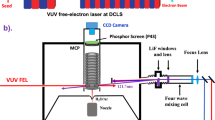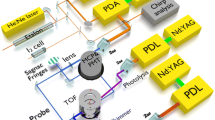Abstract
We apply state-resolved molecular kinetics to study the chemical evolution of the primordial Universe. In particular, the vibrationally resolved kinetics of the most abundant molecular species, H2 and its cation H +2 , is calculated by solving a master equation. The results show that the vibrational level populations of these two species are not in local thermal equilibrium for a wide range of redshifts. We discuss possible effects of such non-equilibrium distributions on the cosmic background radiation.

Similar content being viewed by others
References
Coppola CM, Longo S, Capitelli M, Palla F, Galli D (2011) Vibrational level population of H2 and H +2 in the early Universe. ApJS 193:7
Galli D, Palla F (1998) The chemistry of the early Universe. A&A 335:403–420
Hirata CM, Padmanabhan N (2006) Cosmological production of H2 before the formation of the first galaxies. MNRAS 372:1175–1186
Kolb EW, Turner MS (1990) The early Universe. Addison-Wesley, Redwood
Komatsu E, Dunkley J, Nolta MR, Bennett L, Gold CB, Hinshaw G, Jarosik N, Larson D, Limon M, Page L, Spergel DN, Halpern M, Hill RS, Kogut A, Meyer SS, Tucker GS, Weiland JL, Wollack E, Wright EL Five-year Wilkinson microwave anisotropy probe observations: cosmological interpretation. ApJS 180(2):330
Lepp S, Dalgarno A (1987) Chemistry in the early Universe. IAU Symp 120:109–120
Lepp S, Stancil PC, Dalgarno A (2002) Atomic and molecular processes in the early Universe. J Phys B 35(10): R57–R80
Padmanabhan T (2002) Theoretical astrophysics, vol III. Galaxies and cosmology. Cambridge University Press, Cambridge
Peebles PJE (1993) Principles of physical cosmology. Princeton University Press, Princeton
Puy D, Alecian G, Le Bourlot J, Léorat J, Pineaudes Forêts G (1993) Formation of primordial molecules and thermal balance in the early Universe. A&A 267:337–346
Schleicher DR, Galli D, Palla F, Camenzind M, Klessen RS, Bartelmann M, Glover SCO (2008) Effects of primordial chemistry on the cosmic microwave background. A&A 490:521–535
Seager S, Sasselov DD, Scott D (2000) How exactly did the Universe become neutral? ApJS 128(2):407–430
Stancil PC, Lepp S, Dalgarno A (1998) The deuterium chemistry of the early Universe. ApJ 509(1):1–10
Vonlanthen P, Rauscher T, Winteler C, Puy D, Signore M, Dubrovich V (2009) Chemistry of heavy elements in the dark ages. A&A 503:47–59
Acknowledgments
S.L., M.C. and C.M.C. would like to acknowledge Università degli Studi di Bari "Aldo Moro", that partially supported this project (fondi d’Ateneo 2010).
Author information
Authors and Affiliations
Corresponding author
Rights and permissions
About this article
Cite this article
Longo, S., Coppola, C.M., Galli, D. et al. The role of vibrationally excited molecules in the chemistry of the early Universe. Rend. Fis. Acc. Lincei 22, 119–123 (2011). https://doi.org/10.1007/s12210-011-0119-3
Received:
Accepted:
Published:
Issue Date:
DOI: https://doi.org/10.1007/s12210-011-0119-3




